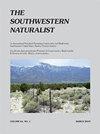得克萨斯州白头鸽的第二性和第三性比
IF 0.2
4区 环境科学与生态学
Q4 Agricultural and Biological Sciences
引用次数: 0
摘要
摘要性别比是影响野生动物物种人口统计的重要参数。性比分为初级(受精时的性)、次级(出生时的性早熟)、三级(成年时的性)和四级(生殖后的性)。在这里,我们检查了白翼鸽子(亚洲泽奈达)的第二个1(孵化)、第二个2(幼年或亚成年)和第三个(成年)性别比。此外,由于白翼鸽子通常孵化两个鸡蛋,我们还评估了共同发生的巢穴的第二性比。有趣的是,二级和少年性比明显有男性偏见,而三级性比没有偏见。此外,同性巢穴的比例也有男性偏见。第三级缺乏偏见支持费舍尔的原则,即1:1的性别比存在差异选择,并导致人口更加稳定。因此,我们的结论是,鉴于我们在中学和青年性别比水平上的调查结果,在这一物种中存在一些选择机制,选择达到成年地位的男性。摘要性别比例是影响野生物种人口统计的重要参数。性别比例分为小学(受精性别)、中学(出生时/不成熟性别)、三年级(成年性别)和四年级(生殖后年龄性别)。在这里,我们检查了Aliblancas(Zenaida asiatica)鸽子的第二级(繁殖)、第二级(幼年或亚幼年)和第三级(成年)。此外,由于Aliblanca鸽子通常孵化两个鸡蛋,我们还评估了共存雏鸟的二级性别比例。有趣的是,第二性别和青年性别的比例明显受到男性的偏见,而第三性别的比例则没有。此外,同性雏鸡的比例也受到男性的偏见。高等教育比例缺乏偏见支持费舍尔的原则,即1:1的性别比例存在差异选择,并导致人口更加稳定。因此,我们得出的结论是,鉴于我们在中学和青年性别比例方面的发现,在这个物种中存在一些选择机制,它选择这样的物种,使雄性无法达到成年状态。本文章由计算机程序翻译,如有差异,请以英文原文为准。
SECONDARY AND TERTIARY SEX RATIOS IN WHITE-WINGED DOVES (ZENAIDA ASIATICA) IN TEXAS
Abstract Sex ratio is an important parameter influencing the demography of wildlife species. Sex ratios are categorized as primary (sex at fertilization), secondary (sex at birth through immaturity), tertiary (sex at adulthood), and quaternary (sex at post-reproductive age). Herein, we examined the secondary1 (hatchling), secondary2 (juvenile or subadult), and tertiary (adult) sex ratios of white-winged doves (Zenaida asiatica). Also, because white-winged doves typically hatch two eggs, we also evaluated the secondary sex ratio of co-occurring nestlings. Interestingly, secondary and juvenile sex ratios were significantly male biased, whereas tertiary sex ratios were not biased. Additionally, the ratio of same-sex nestlings was also male biased. The lack of bias at the tertiary level supports Fisher's principle that differential selection for sex ratios of 1:1 exist and lead to more stable populations. Therefore, we conclude that there is some selection mechanism present in this species that selects against males reaching adult status given our findings at the secondary and juvenile sex ratio levels. Resumen La proporción de sexos es un parámetro importante que influye en la demografía de las especies silvestres. Las proporciones de sexos se clasifican en primarias (sexo en la fecundación), secundarias (sexo al nacer/inmaduro), terciarias (sexo en la edad adulta) y cuaternarias (sexo en la edad pos reproductiva). Aquí, examinamos la secundaria1 (cría), secundaria2 (juveniles o subadultos) y terciarios (adultos) de las palomas aliblancas (Zenaida asiatica). Además, debido a que las palomas aliblancas suelen incubar dos huevos, también evaluamos la proporción de sexos secundarios de los polluelos coexistentes. Curiosamente, las proporciones de sexos secundarios y de juveniles fueron significativamente sesgadas por los machos, mientras que las proporciones de sexos en el terciario no lo fueron. Además, la proporción de polluelos del mismo sexo también estaba sesgada por los machos. La falta de sesgo en la proporción terciaria apoya al principio de Fisher, que existe la selección diferencial para la proporción de sexo de 1:1 y conducen a poblaciones más estables. Por lo tanto, llegamos a la conclusión de que existe algún mecanismo de selección presente en esta especie que selecciona para que los machos no alcancen el estado adulto, dados nuestros hallazgos en la proporción de sexos secundaria y de juveniles.
求助全文
通过发布文献求助,成功后即可免费获取论文全文。
去求助
来源期刊

Southwestern Naturalist
环境科学-生态学
CiteScore
0.50
自引率
50.00%
发文量
47
审稿时长
18-36 weeks
期刊介绍:
The Southwestern Naturalist (a publication of the Southwestern Association of Naturalists since 1953) is an international journal (published quarterly) that reports original and significant research in any field of natural history. This journal promotes the study of plants and animals (living and fossil) in the multinational region that includes the southwestern United States, Mexico, and Central America. Appropriate submission of manuscripts may come from studies conducted in the countries of focus or in regions outside this area that report significant findings relating to biota occurring in the southwestern United States, Mexico, and Central America. Publication is in English, and manuscripts may be feature articles or notes. Feature articles communicate results of completed scientific investigations, while notes are reserved for short communications (e.g., behavioral observations, range extensions, and other important findings that do not in themselves constitute a comprehensive study). All manuscripts (feature articles and notes) require an abstract in both English and Spanish.
 求助内容:
求助内容: 应助结果提醒方式:
应助结果提醒方式:


